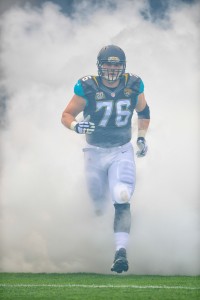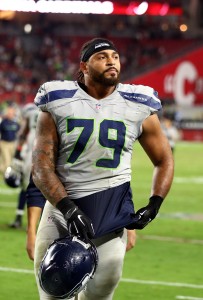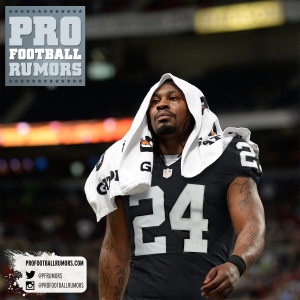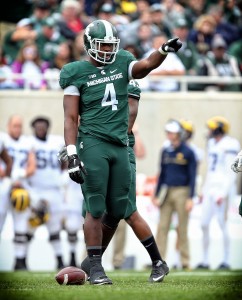After finishing first in Football Outsiders‘ DVOA efficiency metric in each season from 2012-15, the Seahawks fell to ninth in 2016. The fact that that ranking was Seattle’s lowest since 2011 speaks to the consistency of the organization, especially at the top (John Schneider and Pete Carroll each finished among the NFL’s top three general managers and head coaches, respectively, in Patrick Daughtery of Rotoworld’s excellent leadership lists). The Seahawks have advanced to the divisional round of the playoffs in each of the past five campaigns, and have shown a remarkable ability to lock up core players in order to maintain their run of success.
That’s not to say Seattle didn’t have areas to address this offseason, however, so let’s take a look at how Seattle fared:
Notable signings:
- Luke Joeckel, T: One year, $8MM. $7MM guaranteed.
- Eddie Lacy, RB: One year, $4.25MM. $2.865MM guaranteed. $1.3MM available via incentives.
- Luke Willson, TE: One year, $1.8MM. Fully guaranteed.
- DeShawn Shead, CB: One year, $1.2MM. $1MM guaranteed.
- Bradley McDougald, S: One year, $1.8MM. $750K guaranteed.
- Neiko Thorpe, S: Two years, $1.75MM. $600K guaranteed.
- Michael Wilhoite, LB: One year, $1.55MM. $500K guaranteed.
- Oday Aboushi, G: One year, $975K. $200K guaranteed.
- Terence Garvin, LB: One year, minimum salary benefit. $80K guaranteed.
- Austin Davis, QB: One year, minimum salary benefit. $50K guaranteed.
- Blair Walsh, K: One year, $1.1MM.
- David Bass, LB: One year, minimum salary benefit.
- Arthur Brown, LB: One year, minimum salary benefit.
- Marcus Cromartie, CB: One year, $690K.
- Dion Jordan, DE: One year, $640K.
As I noted when assessing the Seahawks’ most pressing needs heading into the offseason, Seattle’s offensive line could have been listed first, second, and third on a list of the club’s glaring weaknesses. After ranking 25th in adjusted sack rate and 26th in adjusted line yards in 2016, the Seahawks and general manager John Schneider addressed the problem in free agency — something they didn’t do a year ago — by adding former No. 2 overall pick Luke Joeckel on a one-year pact.
Joeckel received $8MM from Seattle, with $7MM of that total coming as a full guarantee. It’s an astonishing figure for a player who’s been considered a complete bust, and it’s hard to believe Joeckel was drawing enough interest to force the Seahawks to land at that number. Other offensive linemen earning ~$8MM include Marshal Yanda, Mike Iupati, Morgan Moses, and Brandon Brooks, all of whom are in a different stratosphere from Joeckel in terms of production. Former first-round selection D.J. Fluker scored only $3MM from the Giants on a single-season deal this spring, and Joeckel should have come in around the same amount.
Even more surprising is that Joeckel may not even play left tackle! The Seahawks are reportedly considering placing George Fant, who graded as Pro Football Focus‘ single-worst tackle in the NFL last season, on the blindside, meaning Joeckel would likely stick at guard, or perhaps even be forced to act as a reserve. Either way, Seattle’s financial commitment to Joeckel makes no sense if he’s not at least starting at left tackle, as his $8MM salary would make him the 11th-highest-paid guard in the league.
After securing the No. 2 pick in the 2013 draft in Joeckel, the Seahawks also brought in the third overall selection from that draft: defensive end Dion Jordan, who’s been an even larger disappointment during his NFL tenure than Joeckel. The 27-year-old Jordan hasn’t played in a game since December 2014, with PED-related suspensions and knee issues delaying his return to the field. Seattle’s gamble on Jordan is more palatable than its Joeckel bet, especially given that Jordan only inked a minimum salary deal with no guaranteed money. If Jordan does earn a roster spot and perform well, the Seahawks can control him through 2018 as a restricted free agent.
While the Joeckel and Jordan risks are based on performance concerns, the main uncertainly with cornerback DeShawn Shead is his health, as he’s coming off a torn ACL suffered in Week 15. After being non-tendered and then re-signed, Shead is expected to begin the season on the physically unable to perform list, as head coach Pete Carroll said in March he’d be “really surprised” if Shead was able to suit up for Week 1. A 15-game starter a season ago, Shead played more than 1,000 defensive snaps and graded as the league’s No. 37 corner, per PFF.
Joining Shead in the defensive backfield will be Bradley McDougald, an excellent value signing by the Seahawks at cost of only $1.8MM. McDougald, who started 31 games for the Buccaneers over the past two years, will serve as a third safety for Seattle, but could conceivably be forced into action based on injury questions with the Seahawks’ starts. Earl Thomas is expected to be ready for the season opener as he recovers from a broken leg, but complications could certainly arise. Kam Chancellor, meanwhile, is working his way back from multiple ankle surgeries and wasn’t yet at full speed as of March.
Seattle didn’t make many other notable additions on defense, although it did load up on linebackers/defensive backs with special teams experience. While the Seahawks graded among the top half of the league in special teams DVOA, their No. 13 ranking was a ten-spot drop from 2015. Perhaps with the intent of pushing that ranking back up, the Seahawks signed Terence Garvin, Michael Wilhoite, David Bass, Neiko Thorpe, and Arthur Brown, all of whom played on more than 45% of their respective team’s special teams snaps in 2016. Not every member of that cadre will end up making Seattle’s roster, but as a group, it’s a cheap investment with an eye towards special teams improvement.
The Seahawks’ most high-profile signing was former Packers running back Eddie Lacy, whom Seattle landed on a one-year contract worth $4.25MM. Lacy hasn’t posted a complete, healthy season since 2014, and given that his conditioning has been questioned, the Seahawks inserted weight clauses into Lacy’s deal. He passed his first weigh-in last month, earning $55K for tipping the scales below 250 pounds. Lacy, who is still only 26 years old, will join a Seattle backfield that also includes Thomas Rawls, C.J. Prosise, Alex Collins, and Mike Davis. Bob Condotta of the Seattle Times indicated last month that Lacy and Rawls will likely split basedown touches while Prosise handles passing game work.
After considering Colin Kaepernick, the Seahawks landed on Austin Davis as their free agent quarterback addition. Davis hasn’t played since 2015, and has only attempted only 378 career passes, but it’s not even clear that he’ll in fact be Russell Wilson‘s direct backup. Trevone Boykin, a 2016 undrafted free agent who served behind Wilson last year, has avoided jail time for at least one legal incident and isn’t expected to be suspended by the NFL. If he’s available, Boykin will likely relegate Davis to the No. 3 job (or off the roster).
Notable losses:
- Brock Coyle, LB: Non-tendered
- Garry Gilliam: Seahawks declined to match 49ers RFA offer sheet
- Steven Hauschka, K
- Devin Hester, WR
- John Jenkins, DT
- Jeron Johnson, S
- Kelcie McCray, S
- Tony McDaniel, DT
- Damontre Moore, DE
- Mike Morgan, LB
- Troymaine Pope, RB: Waived
- Tyvis Powell, S: Waived
- Marcel Reece, FB
- Mohammed Seisay, CB: Non-tendered
- Bradley Sowell, T
- Steven Terrell, S: Non-tendered
- Will Tukuafu, FB
- Brandon Williams, TE
In terms of losses, the Seahawks had a fairly nondescript offseason, as none of the club’s defections posted an approximate value (Pro Football Reference’s catch-all metric) above three. Kicker Steven Hauschka is the most notable player who won’t return to Seattle, and his loss was expected after the Seahawks signed former Vikings kicker Blair Walsh. While Hauschka finished seventh among kickers with an 89% field goal percentage, he converted only 83% of his extra point attempts, 32nd in the league. Still, the Seahawks were seven points above average on kicks a year ago, per Football Outsiders, so Hauschka will be missed.
Unlike Hauschka, Garry Gilliam wasn’t an unrestricted free agent, but he’ll still be leaving the Pacific Northwest after inking a restricted free agent offer sheet with the division-rival 49ers. The Seahawks didn’t get any draft pick compensation since they tendered the formerly undrafted Gilliam at the original round level, but Seattle didn’t seem all that interested in retaining Gilliam anyway. San Francisco’s offer to Gilliam was only $400K more than what he would’ve earned with the Seahawks, but given that he ranked as a bottom-10 offensive tackle per PFF, Seattle didn’t bother to make up the difference.
Mike Morgan, 29, was nominally the Seahawks’ starting strongside linebacker in 2016, but because Seattle spent so much time in nickel, Morgan’s defensive snaps were limited. Morgan’s contributions were further restricted by injury last year, as he spent eight weeks on injured reserve while dealing with a sports hernia. All told, Morgan played only 138 defensive snaps and posted just 10 tackles. He’s auditioned for the Jaguars and Saints, but has yet to land a contract.
Trades:
- Acquired a 2018 fifth-round pick from the Raiders in exchange for RB Marshawn Lynch and a 2018 sixth-round pick.
- Acquired a 2017 first-round pick (No. 31), a 2017 third-round pick (No. 95; S Delano Hill), and a 2017 seventh-round pick (No. 249; RB Chris Carson) from the Falcons in exchange for a 2017 first-round pick (No. 25; DE Takkarist McKinley).
- Acquired a 2017 second-round pick (No. 34) and a 2017 fourth-round pick (No. 111; S Tedric Thompson) from the 49ers in exchange for a 2017 first-round pick (No. 31; LB Reuben Foster).
- Acquired a 2017 second-round pick (No. 35; DT Malik McDowell) and a 2017 sixth-round pick (No. 187; S Mike Tyson) from the Jaguars in exchange for a 2017 second-round pick (No. 34; T Cam Robinson).
Had Marshawn Lynch un-retired with the intention of playing for the Seahawks, Seattle likely would have released him and attempted to recoup $2.5MM of his signing bonus from 2016. Lynch, unsurprisingly, had no interest in paying back that money, while the Seahawks couldn’t afford Lynch’s $9MM cap charge on their books. In the end, Seattle worked out a trade with the Raiders, shipping Lynch to Oakland in exchange for a minimal draft pick swap. The talks were likely aided by the close relationship between Seahawks general manager John Schneider and Raiders GM Reggie McKenzie, each of whom are former Packers staffers.
For the fourth time in five years, Seattle didn’t have a first-round selection, and this time it was because of another trade. The Seahawks acquired 130 cents on the dollar by simply moving from pick No. 25 to No. 31, according to Chase Stuart of Football Perspective‘s trade value calculator. Then, they flipped that choice for 131 cents on the dollar, before ultimately moving to No. 35 for 109 cents on the dollar.
While the original move from No. 25 to No. 31 made sense, it’s fair to argue Seattle should have sat tight at No. 31, especially given the amount of offensive linemen still available. Clearly, hindsight is 20/20 and the Seahawks didn’t know where prospects were going to land, but Wisconsin’s Ryan Ramczyk came off the board at No. 32, while Seattle gave away No. 34 to the Jaguars, who selected Alabama’s Cam Robinson. Either of those players would have been a welcome addition to the Seahawks’ porous front five.
Draft picks:
- 2-35: Malik McDowell, DT (Michigan State)
- 2-58: Ethan Pocic, OL (LSU)
- 3-90: Shaquill Griffin, CB (UCF)
- 3-95: Delano Hill, S (Michigan)
- 3-102: Nazair Jones, DL (North Carolina)
- 3-106: Amara Darboh, WR (Michigan)
- 4-111: Tedric Thompson, S (Colorado)
- 6-187: Mike Tyson, S (Cincinnati)
- 6-210: Justin Senior, T (Mississippi State)
- 7-226: David Moore, WR (East Central Oklahoma)
- 7-249: Chris Carson, RB (Oklahoma)
The interior of the Seattle’s defensive line didn’t fare as well as its edge players in 2016, as defensive tackles Tony McDaniel, Jarran Reed, and Ahtyba Rubin graded as the league’s No. 52, No. 91, and No. 113 interior defenders among 127 qualifiers, respectively, according to PFF. McDaniel is now a member of the Saints, and while Reed should improve as he enters his second NFL campaign, he’s more of a run-stuffer than a penetrator. The Seahawks needed a big body in the middle capable of shooting gaps and getting after quarterbacks, and Malik McDowell has the potential to be that player.
As Sam Gold of Field Gulls mentioned in his post-draft analysis of the McDowell pick, the former Michigan State Spartan will likely play the weakside defensive tackle role in Seattle, with taking down opposing signal-callers serving as his main goal. Gold compares McDowell to Bengals defensive end Carlos Dunalp, while I see a bit of Kansas City’s Chris Jones. McDowell faced effort questions during his collegiate career, but if he can maximize his talents at the professional level, he could be a steal for the Seahawks.
Shaquill Griffin, a favorite of Pro Football Focus’ Sam Monson, may be asked to step into the Legion of Boom relatively quickly, as he could play outside in nickel packages while Jeremy Lane slides into the slot. Among collegiate corners who played at least 250 snaps a season ago, Griffin earned the fifth-highest grade from PFF. LSU’s Ethan Pocic, meanwhile, is a “flexible, natural athlete” who can play all five spots on the offensive line, per Lance Zierlein of NFL.com. He should be Seattle’s top reserve lineman during his rookie season.
Other:
- Claimed RB Mike Davis off waivers from the 49ers.
- Signed eight undrafted rookie free agents.
Top 10 cap charges for 2017:
- Russell Wilson, QB: $18,800,000
- Richard Sherman, CB: $13,361,000
- Michael Bennett, DL: $10,756,250
- Earl Thomas, S: $10,400,000
- Jimmy Graham, TE: $10,000,000
- Doug Baldwin, WR: $9,650,000
- Kam Chancellor, S: $8,125,008
- Bobby Wagner, LB: $7,600,000
- Luke Joeckel, T: $7,250,000
- K.J. Wright, LB: $6,800,000
The Seahawks look like one of the safest bets to earn a postseason bid in 2017, as the rest of the NFC West comprised of two rebuilding clubs (the 49ers and Rams) another team (the Cardinals) with an aging roster. In a piece for ESPN insider, Aaron Schatz of Football Outsiders projected Seattle to win 11 games, third in the NFL behind the Patriots and Steelers. Of course, the 2017 campaign probably won’t be considered a success unless the Seahawks bring home the Lombardi trophy once again.
Information from Over the Cap and Roster Resource was used in the creation of this post. Photos courtesy of USA Today Sports Images.